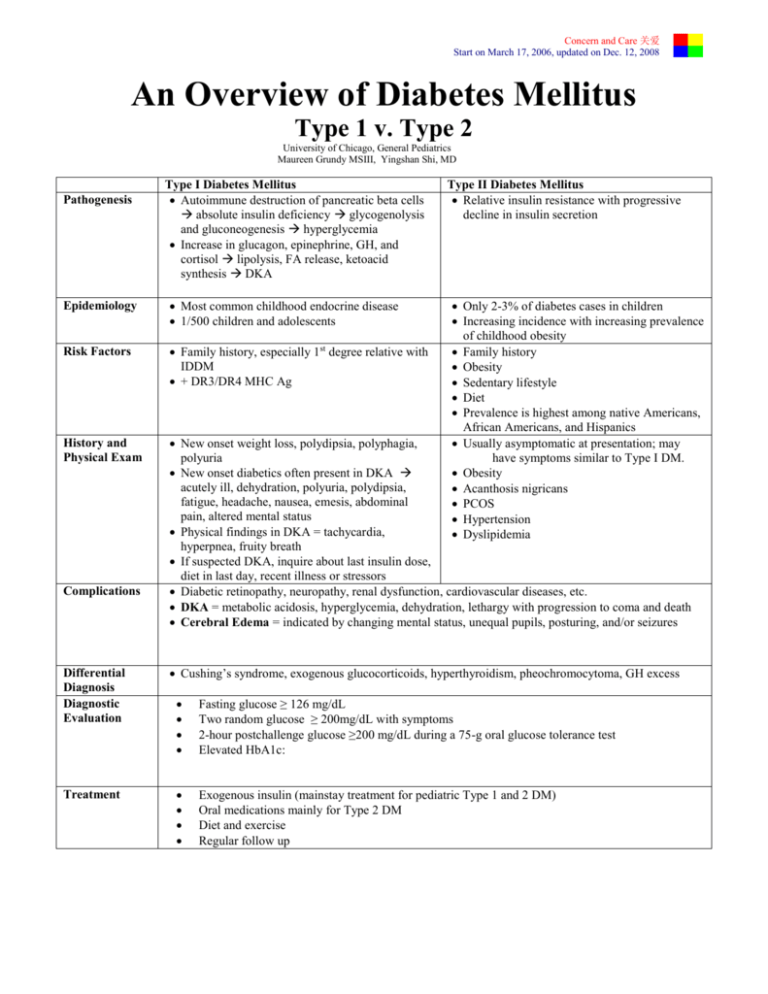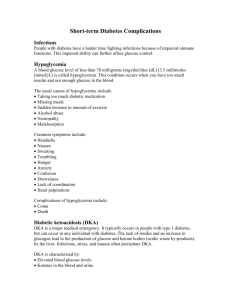DM Overview - Funandeducation.org
advertisement

Concern and Care 关爱 Start on March 17, 2006, updated on Dec. 12, 2008 An Overview of Diabetes Mellitus Type 1 v. Type 2 University of Chicago, General Pediatrics Maureen Grundy MSIII, Yingshan Shi, MD Pathogenesis Type I Diabetes Mellitus Autoimmune destruction of pancreatic beta cells absolute insulin deficiency glycogenolysis and gluconeogenesis hyperglycemia Increase in glucagon, epinephrine, GH, and cortisol lipolysis, FA release, ketoacid synthesis DKA Type II Diabetes Mellitus Relative insulin resistance with progressive decline in insulin secretion Epidemiology Most common childhood endocrine disease 1/500 children and adolescents Risk Factors Family history, especially 1st degree relative with IDDM + DR3/DR4 MHC Ag History and Physical Exam New onset weight loss, polydipsia, polyphagia, polyuria New onset diabetics often present in DKA acutely ill, dehydration, polyuria, polydipsia, fatigue, headache, nausea, emesis, abdominal pain, altered mental status Physical findings in DKA = tachycardia, hyperpnea, fruity breath If suspected DKA, inquire about last insulin dose, diet in last day, recent illness or stressors Diabetic retinopathy, neuropathy, renal dysfunction, cardiovascular diseases, etc. DKA = metabolic acidosis, hyperglycemia, dehydration, lethargy with progression to coma and death Cerebral Edema = indicated by changing mental status, unequal pupils, posturing, and/or seizures Complications Differential Diagnosis Diagnostic Evaluation Treatment Only 2-3% of diabetes cases in children Increasing incidence with increasing prevalence of childhood obesity Family history Obesity Sedentary lifestyle Diet Prevalence is highest among native Americans, African Americans, and Hispanics Usually asymptomatic at presentation; may have symptoms similar to Type I DM. Obesity Acanthosis nigricans PCOS Hypertension Dyslipidemia Cushing’s syndrome, exogenous glucocorticoids, hyperthyroidism, pheochromocytoma, GH excess Fasting glucose ≥ 126 mg/dL Two random glucose ≥ 200mg/dL with symptoms 2-hour postchallenge glucose ≥200 mg/dL during a 75-g oral glucose tolerance test Elevated HbA1c: Exogenous insulin (mainstay treatment for pediatric Type 1 and 2 DM) Oral medications mainly for Type 2 DM Diet and exercise Regular follow up Concern and Care 关爱 Start on March 17, 2006, updated on Dec. 15, 2008 Who Should Be Screened for Diabetes? Type 1 Diabetes Screening children for DM1 is not indicated. Children with DM1 will present clinically with new onset weight loss, polyuria, polyphagia, and/or polydipsia. Findings on history and physical dictate further work up to diagnose DM1. Type 2 Diabetes Most pediatric patients with DM2 will be asymptomatic at clinical presentation. Therefore, screening children and adolescents who meet certain criteria for DM2 is indicated. 1. What are the criteria for testing for DM2 in children and teens? Overweight (BMI>85th percentile for age and gender, weight for height >85 th percentile, OR weight > 120% of ideal for height) AND Any 2 of the following risk factors: - Family history of Type 2 DM in first or second degree relatives - Race/ethnicity of American Indian, African American, Hispanic/Latino, Asian/American, or Pacific Islander - Signs of insulin resistance (acanthosis nigricans, hypertension, dyslipidemia, PCOS) 2. At what age should testing for DM2 begin? 10 years OR at onset of puberty if earlier than 10yo 3. What test should be used? Fasting plasma glucose: A fasting plasma glucose > or = 126mg/dL is diagnostic for diabetes. Fasting is defined as no food or beverage other than water for at least 8 hours before the test 4. How often should testing occur? Every 2 years References: UpToDate – www.uptodate.com DynaMed – www.dynamicmedical.com Blueprints Pediatrics 3rd Edition 2004, p57-59. AACE DM guidelines. Glycemic management Endocr Pract 2007 May-Jun;13(Suppl 1):16-34. [178 references] Management of diabetes mellitus: Glycemic management AACE 2000 Jan (revised 2007). NGC:005853 AAP Clinical Report: Prevention and Treatment of Type 2 Diabetes Mellitus in Children, With Special Emphasis on American Indian and Alaska Native Children. Pediatrics 2003; 112; e328-e347. (Downloaded from http://www.pediatrics.org/cgi/content/full/112/4/e328) An Update on Type 2 Diabetes in Youth from the National Diabetes Education Program. (Downloaded from http://www.pediatrics.org) Type 2 Diabetes in Children and Adolescents. Pediatrics 2000;105; 671-680. (Downloaded from http://www.pediatrics.org) ADA Position Statement. Standards of Medical Care in Diabetes 2006. Diabetes Care 2006; 29; S26-S29.







